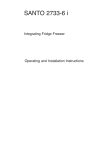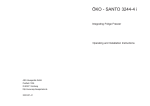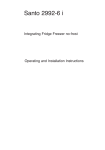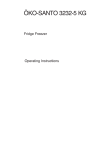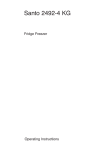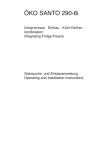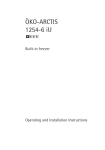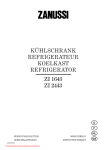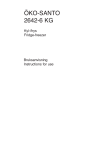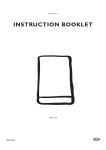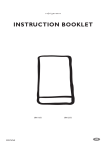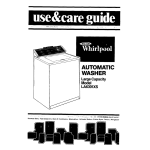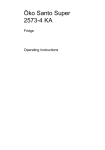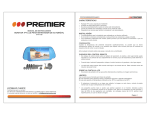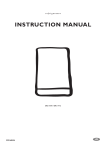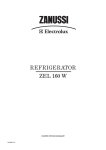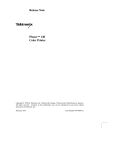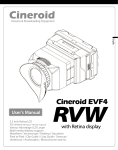Download Electrolux 1333-6 i User's Manual
Transcript
ARCTIS 1333-6 i Integrating Freezer Operating and Installation Instructions Dear customer, Before placing your new refrigerator/freezer into operation please read these operating instructions carefully. They contain important information for safe use, for installation and for care of the appliance. Please keep these operating instructions for future reference. Pass them on to possible new owners of the appliance. Notes which are important for your safety or for the proper functioning of the appliance are stressed with a warning triangle and/or with signal words (Warning!, Important!, Attention!). Please observe the following instructions carefully. Additional information regarding operation and practical applications of the appliance appear after this symbol. Tips and notes concerning economical and environmentally sound use of the appliance are marked with the flower. In the event of a malfunction, these operating instructions contain information on how to rectify faults yourself, see the ÒSomething Not WorkingÓ section. For futher assistance contact your local AEG Service Force Centre, see the chapter ÒService & Spare Parts. 2 Contents Safety . . . . . . . . . . . . . . . . . . . . . . . . . . . . . . . . . . . . . . . . . . . 4 Disposal . . . . . . . . . . . . . . . . . . . . . . . . . . . . . . . . . . . . . . . . . 5 Appliance Packaging Information . . . . . . . . . . . . . . . . . . . . . . . 5 Disposal of old Appliances . . . . . . . . . . . . . . . . . . . . . . . . . . . . 5 Remove transport packaging . . . . . . . . . . . . . . . . . . . . . . . . . 6 Starting up and temperature regulation . . . . . . . . . . . . . . . . . 7 Freezing and storing frozen food . . . . . . . . . . . . . . . . . . . . . . 9 Preparation of Ice Cubes . . . . . . . . . . . . . . . . . . . . . . . . . . . .11 Frozen Food Symbols/ Freezing calendar . . . . . . . . . . . . . . .11 Defrosting . . . . . . . . . . . . . . . . . . . . . . . . . . . . . . . . . . . . . . . . . 11 Switching off the appliance . . . . . . . . . . . . . . . . . . . . . . . . . . . 12 Cleaning and Care . . . . . . . . . . . . . . . . . . . . . . . . . . . . . . . . . . 13 Energy Saving Tips . . . . . . . . . . . . . . . . . . . . . . . . . . . . . . . . . 14 Something Not Working. . . . . . . . . . . . . . . . . . . . . . . . . . . . . 15 Changing the light bulb . . . . . . . . . . . . . . . . . . . . . . . . . . . . . . . 16 Service and Spare Parts. . . . . . . . . . . . . . . . . . . . . . . . . . . . . . 17 Guarantee Conditions . . . . . . . . . . . . . . . . . . . . . . . . . . . . . . . 18 Installation . . . . . . . . . . . . . . . . . . . . . . . . . . . . . . . . . . . . . . . 19 Electrical Connection . . . . . . . . . . . . . . . . . . . . . . . . . . . . . . . . . 19 Installation Location . . . . . . . . . . . . . . . . . . . . . . . . . . . . . . . . . . 20 Your appliance needs air . . . . . . . . . . . . . . . . . . . . . . . . . . . . . 20 Reversing the door . . . . . . . . . . . . . . . . . . . . . . . . . . . . . . . . . .21 Housing dimensions . . . . . . . . . . . . . . . . . . . . . . . . . . . . . . . . .21 Instructions for total building in . . . . . . . . . . . . . . . . . . . . . . . . . .22 Regulations, Standards, Guidelines. . . . . . . . . . . . . . . . . . . . 25 2222 189-72 3 Safety Please read this instruction book before using the appliance and retain for future reference. These warnings are provided in the interests of your safety, ensure you understand them fully before using the appliance. Intended use ¥ The appliance is intended for use in the home. It is suitable for the freezing and storing of frozen food, as well as for making ice. If the appliance is used for purposes other than those intended or used incorrectly, no liability can be accepted by the manufacturer for any damage that may be caused. ¥ Alterations or changes to the appliance are not permitted for reasons of safety. Prior to initial startÐup ¥ Check the appliance for transport damage. Under no circumstance should a damaged appliance be plugged in! In the event of damage, please contact your retailer. Refrigerant The refrigerant isobutane (R600a) is contained within the refrigerant circuit of the appliance, a natural gas with a high level of environmental compatibility, which is nevertheless flammable. ¥ During transportation and installation of the appliance, be certain that none of the components of the refrigerant circuit become damaged. ¥ If the refrigerant circuit should become damaged: Ð avoid open flames and sources of ignition; Ð thoroughly ventilate the room in which the appliance is situated. Safety of children ¥ Keep packaging material away from children. ¥ Please make old appliances unusable prior to disposal. Pull out the mains plug, cut off the mains cable and remove any locks or catches, to prevent young children being trapped inside. ¥ Do not allow children to tamper with the controls or play with the product. Daily Operation ¥ Containers with flammable gases or liquids can leak at low temperatures. There is a risk of an explosion! Do not store any containers with flammable materials such as, spray cans, fire extinguisher refill 4 cartridges etc in the refrigerator/freezer. ¥ Bottles and cans must not be placed in the freezer compartment. They can burst when the contents freeze, high carbonate content drinks can even explode! Never store lemonade, juices, beer, wine, sparkling wine etc. in the freezer compartment. ¥ Ice cream or ice cubes can cause Òfrost/freezerÓ burns if consumed straight from the freezer. ¥ Do not touch frozen food with wet hands. Your hands could stick to the food. ¥ Do not operate any electrical appliances in the refrigerator/freezer (e.g. electric ice cream makers, mixers etc.). ¥ Before cleaning the appliance, always switch off the appliance and disconnect from the electricity supply. ¥ When unplugging always pull the plug from the mains socket, do not pull on the cable. Service ¥ Under no circumstances should you attempt to repair the appliance yourself. Repairs carried out by inexperienced persons may cause injury or serious malfunctioning. Contact your local AEG Service Force Centre. Disposal Appliance Packaging Information All materials are environmentally sound. The plastics can be recycled and are identified as follows: >PE< for polyethylene, e.g. the outer covering and the bags in the interior. >PS< for polystyrene foam, e.g. the pads, which are all free of chlorofluorocarbon. The carton parts are made from recycled paper and should be disposed of at a waste-paper recycling collection location. Disposal of old Appliances For environmental reasons, refrigeration appliances must be disposed of properly. This applies to your old appliance, and - at the end of its service life - to your new appliance as well. 5 Warning! Before disposing of old appliances make them inoperable. Remove plug from mains, sever the power cable, remove or destroy any snap or latch closures, to prevent small children being trapped inside. ¥ Contact your local Council or Environmental Health Office to see if there are facilities in your area to recycle the appliance. Remove transport packaging The appliance and the interior fittings are protected for transport. ¥ Remove all adhesive tape and packing pieces from the interior of the appliance. You can remove any remnants of adhesive using white spirit. 6 Operating and indicator panel A A Fast feezing push button B Fast feezing light (yellow) C Alarm light (red) D Operating light (green) E ON/OFF push button F Temperature control knob B C D E F The green pilot lamp (D), which comes on when the mains voltage is available and the ON/OFF button is pushed. Turn the temperature control knob to a number position, the tempeature will be automatically regulated.. The temperature control knob (F), which can be used to obtain variable setting of the most energy saving storage temperature for your frozen food. The optimum storage conditons occur at -18¡C and can be +10 checked at the thermometer °C 0 -18 (fig.). The yellow pilot light (B) comes on when the fast freeD008 zing button (A) has been operated. The refrigerating unit then operates continuously. The red temperature pilot-lamp (C) comes on when: Ð the appliance has been started up but the storage temperature has not yet been attained; Ð the minimum storage temperature is no longer being maintained (fault); 7 Ð excessive amounts of fresh food are placed inside; or Ð if the appliance door is open for too long. Important note: if you operate the fast-freeze switch or adjust the temperature control knob, the motor might not start immediately but only after some time. This does not mean that your appliance has a fault. Audible temperature alarm Your freezer is equipped with an audible temperature alarm, an acoustic warning sounds simultaneously with illumination of the red temperature pilot lamp, alerting you to the fact that the storage temperature in your freezer is too high or too warm. The audible warning sounds until it is switched off by operation of the fast-freeze button. Starting up and temperature regulation Please clean the appliance interior and all accessories prior to starting the appliance. Plug in the appliance at the mains supply. ¥ Push the ON/OFF button (E) The green lamp (D) comes on. ¥ Turn the temperature control knob (F) in the direction of ã1Ò. ¥ The red lamp (C) comes on, the audible warning sounds , and the refrigeration motor starts up. ¥ Operate the fast-freeze button (A). The yellow pilot lamp (B) comes on and the audible warning stops. ¥ Only when the red lamp (C) has gone out should you reset the fastfreeze button (A) the yellow light (B) goes out. Setting Ò0Ó: Off. Setting Ò1Ó: Hightest temperature, (warmest setting). Setting Ò4Ó (end-stop) : Lowest temperature, (coldest setting). The exact setting should be chosen keeping in mind that the temperature inside the appliance depends on: - the quantity of food stored - how often the door is opened - ambient temperature Important: Regularly check on the red temperature pilot lamp (C) and the thermometer that the required storage temperature is being maintained. 8 Ice pack There is an ice pack in one drawer of the freezer. In the event of a power failure or malfunction, the ice pack will lengthen the amount of time it takes for the frozen food to become too warm by several hours. The ice pack can only fulfil this task efficiently if it is placed in the uppermost drawer, at the front, above the frozen food. You can use the ice pack for cooling cold bags. Freezing and storing frozen food You can use your freezer for freezing fresh food yourself. Important! ¥ The temperature in the freezer compartment must be Ð18 ¡C or colder before freezing food. ¥ Please observe the freezing capacity given on the rating plate. The freezing capacity is the maximum quantity of fresh food that can be frozen within a period of 24 hours. If you wish to freeze food several days in a row, please observe a maximum capacity of only 2/3 to 3/4 of that on the rating plate. The quality of the food is best preserved when it is frozen right through to the core as quickly as possible. ¥ Allow warm food to cool down before freezing. The warmth will cause increased ice formation and increase the power consumption. ¥ Please note the maximum storage times specified by the manufacturer. ¥ Thawed foods which have not been processed further (cooked into meals) may not under any circumstances be frozen a second time. ¥ Containers with flammable gases or liquids can leak at low temperatures. There is a risk of an explosion! Do not store any containers with flammable materials such as, for example, spray cans, fire extinguisher refill cartridges etc in the refrigerator/freezer. ¥ Bottles and cans must not be placed in the freezer. They can burst when the contents freeze, high carbonate content drinks can even explode! Never store lemonade, juices, beer, wine, sparkling wine etc. in the freezer. ¥ All foods must be packed air tight prior to freezing, so that they do not dry out or lose their flavour, and so that no flavour contamination of other frozen goods occurs. 9 Important! Do not touch frozen food with wet hands. Your hands could stick to the food. 1. 2. 3. Place the packed food in the drawers. Place food to be frozen as shown in figure. Unfrozen food must not touch items already frozen, otherwise the frozen food could begin to defrost. Press the fast freeze button 24 hours before introducing fresh food for freezing of fresh food. The yellow light comes on. 9 Kg 7 Kg D670 Place frozen foods in the drawers sorted by type, as far as possible. Index tabs are supplied for placing on drawers. To mark the contents of the individual drawers, press the rider over the corresponding symbol (see "Frozen Food Symbols/Freezer Calendar" section). This will give you a better overview of the contents, avoid extended door opening and therefore save electricity. Preparation of Ice Cubes 1. Fill the ice cube tray 3/4 full with cold water, place it in the freezer compartment and leave to freeze. 2. To loosen the frozen cubes, either twist the ice cube tray or hold it under running water for a few seconds. Important! Never try to free an ice tray that is frozen to the freezer compartment using pointed or sharp edged objects. Use the ice scraper supplied. Frozen Food Symbols/Freezing Calendar ¥ The symbols on the drawers show different types of frozen goods. ¥ The numbers indicate storage times in months for the appropriate types of frozen goods. Whether the upper or lower value of the indicated storage time is valid depends on the quality of the foods and pre-treating before freezing. The lower value applies to foods with high fat content. ¥ By attaching the included index-tabs to the drawers, they can be marked according to which type of foods the individual compartments contain. 10 Defrosting The freezer will become progressively covered with frost. This should be removed with the special plastic scraper provided, whenever the thickness of the frost exceeds 4 mm. During this operation it is not necessary to switch off the power supply or to remove the foodstuffs. However when the ice becomes very thick on the inner liner, complete defrosting should be carried out as follows: 1. Remove the frozen food from the freezer, wrap it in several layers of newspaper and put it in a very cool place. 2. Switch off the appliance and pull out the plug, or turn the temperature regulator to Ò0Ó. 3. Leave the freezer compartment door open. 4. Insert the plastic scraper into the recess provided under the defrost water channel and place a collecting basin under it. 5. Once defrosting is completed keep the scraper for future use; 6. Turn the thermostat control knob to the required setting or replace the plug in the power socket. Warning! Never use metal tools to scrape off the frost Do not use a mechanical device or any artificial means to speed up the thawing process other than those recommended by the manufacturer. A temperature rise of the frozen food packs, during defrosting , may shorten their safe storage life. 11 Switching off the appliance 1. 2. 3. 4. To switch off the appliance, turn the temperature control knob to position "0" or disconnect from the electricity supply. If the appliance is not going to be used for an extended period: Remove all packages as well as ice trays. Remove the mains plug or switch off. Defrost freezer compartment and clean thoroughly (see section: ÒCleaning and CareÓ). Leave the door open to avoid the build up of odours. Cleaning and Care For hygienic reasons the appliance interior, including interior accessories, should be cleaned regularly. Warning! Before carrying out any cleaning or maintenance, disconnect the appliance from the electricity supply. ¥ Never clean the appliance with a steam cleaner. Moisture could accumulate in electrical components and could cause an electrical shock! Hot vapours can lead to the damage of plastic parts. ¥ The appliance must be dry before it is placed back into service. Warning! ¥ Ethereal oils and organic solvents can attack plastic parts, e.g. Ð lemon juice or the juice from orange peel, Ð butyric acid; Ð cleansers which contain acetic acid. Do not allow such substances to come into contact with appliance parts. ¥ Do not use any abrasive cleansers. 12 1. Remove frozen food and the food from the refrigerator. Wrap frozen food in several layers of newspaper. Store it in a cool place, well covered. 2. Switch the appliance off and remove the plug from the mains, or disconnect from the electricity supply. 3. Clean the appliance and the interior accessories with lukewarm water and with a little bicarbonate of soda added (5ml to 0,5 litre of water). 4. Dry the appliance thoroughly. 5. When everything is dry place the appliance back into service. Energy Saving Tips ¥ Do not install the appliance near radiators or other sources of continuous warmth. High ambient temperatures cause longer, more frequent operation of the compressor. ¥ Ensure sufficient air circulation at the appliance base and at the back wall of the appliance. Never cover air vent openings. ¥ Do not place warm foods into the appliance. Allow warm foods to cool first. ¥ Only leave door open as long as necessary. ¥ Do not set temperature any colder than necessary. ¥ Put frozen food in the fridge to defrost. The cold in the frozen food will then be used to cool the fridge. Something Not Working If the appliance is not functioning correctly, please carry out the following checks before contacting your local AEG Service Force Centre. Warning! Repairs should only be carried out by qualified service engineers. Repairs carried out by inexperienced persons may cause injury or serious malfunctioning. 13 Symptom Possible Cause Remedy Appliance is not switched on Switch on the appliance. Mains plug is not plugged in Insert mains plug. or is loose. Appliance does not work. Fuse has blown or is defec- Check fuse, replace if tive. necessary. Socket is defective. Appliance cools too much. Mains malfunctions are to be corrected by an electrician. Temperature is set too cold. Turn the temperature control knob to a warmer setting. Temperature is not properly Please look in the "Initial adjusted. Start Up" section. Door was open for an exten- Open the door only as long ded period. as necessary. The food is too warm. A large quantity of warm food Turn the temperature control was placed in the appliance knob to a colder setting. within the last 24 hours. The appliance is near a heat Please look in the "Installasource. tion location" section. Heavy build up of frost, pos- Door seal is not air tight sibly also on the door seal. (possibly after changing over the hinges). Carefully warm the leaking sections of the door seal with a hair dryer (not hotter than approx. 50 ¡C). At the same time shape the warmed door seal by hand until it sits correctly. The compressor does not This is normal, no error has The compressor starts after start immediately after chan- occurred. a period of time. ging the temperature setting. If, after carrying out the necessary checks there is still a fault with your appliance please contact your local AEG Service Force Centre. In guarantee customers should ensure that the suggested checks have been made as the engineer will make a charge if the fault is not a mechanical or electrical breakdown. Please note that proof of purchase is required for any in-guarantee service calls. 14 Service and Spare Parts If you require a service engineer or wish to purchase spare parts, contact your local AEG Service Force Centre by telephoning: 0870 5 929929 Help us to help you Please determine your type of enquiry before telephoning. When you contasct us we need to know: 1.Your name, address and post code 2.Your telephone number 3.Clear and concise details of the fault - What is the fault? - When does the fault occur? 4.The model, production number and product identification number. This information can be found on the serial plate in the interior at the left of the appliance. ¥ Model Name ¥ Model Number (PNC) ¥ Serial Number (S-No.) 5.Date of purchase Customer Care Department For general enquiries regarding your AEG appliance, or futher information on AEG products please contact our customer care department. Customer Care Department AEG Domestic Appliances 55-77 High Street, Slough, Berkshire SL1 1DZ Tel: 08705 350 350 15 Guarantee Conditions Guarantee Conditions AEG offer the following guarantee to the first purchaser of this appliance. 1. The guarantee is valid for 12 months commencing when the appliance is handed over to the first retail purchaser, which must be verified by purchase invoice or similar documentation. The guarantee does not cover commercial use. 2. The guarantee covers all parts or components which fail due to faulty workmanship or faulty materials. The guarantee does not cover appliances where defects or poor performance are due to misuse, accidental damage, neglect, faulty installation, unauthorised modification or attempted repair, commercial use or failure to observe requirements and recommendations set out in the instruction book. This guarantee does not cover such parts as light bulbs, removable glassware, or plastic. 3. Should guarantee repairs be necessary the purchaser must inform the nearest customer service office (manufacturerÕs service or authorised agent). AEG reserves the right to stipulate the place of the repair (i.e. the customerÕs home, place of installation or AEG workshop). 4. The guarantee or free replacement includes both labour and materials. 5. Repairs carried out under guarantee do not extend the guarantee period for the appliance. Parts removed during guarantee repairs become the property of AEG. 6. The purchaserÕs statutory rights are not affected by this guarantee. European Guarantee If you should move to another country within Europe then your guarantee moves with you to your new home subject to the following qualifications: - The guarantee starts from the date you first purchased your product. - The guarantee is for the same period and to the same extent for labour and parts as exist in the new country of use for this brand or range of products. - This guarantee relates to you and cannot be transferred to another user. - Your new home is within the European Community (EC) or European Free Trade Area. - The product is installed and used in accordance with our instructions and is only used domestically, i.e. a normal household. - The product is installed taking into account regulations in your new country. Before you move please contact your nearest Customer Care Centre, listed below, to give them details of your new home. They will then ensure that the local Service Organisation is aware of your move and able to look after you and your appliances. France Senlis +33 (0)3 44 62 29 29 Germany NŸrnberg +49 (0) 911 323 2600 Italy Pordenone +39 (0) 1678 47053 Sweden Stockholm +46 (0) 8 738 7910 UK Slough +44 (0) 1753 219899 16 Installation Electrical Connection Any electrical work required to install this appliance should be carried out by a qualified electrician or competent person. WARNING Ð THIS APPLIANCE MUST BE EARTHED The manufacturer declines any liability should these safety measures not be observed. Before switching on, make sure the electricity supply voltage is the same as that indicated on the appliance rating plate. The rating plate is inside, on the left. The appliance is supplied with a 13 amp plug fitted. In the event of having to change the fuse in the plug supplied, a 13 amp ASTA approved (BS 1362) fuse must be used. Important! The wires in the mains lead are coloured in accordance with the following code: Green and Yellow . . . . .Earth Blue . . . . . . . . . . . . . . .Neutral Brown . . . . . . . . . . . . . .Live As the colours of the wires in the mains lead of this appliance may not correspond with the coloured markings identifying the terminals in your plug, proceed as follows: 1. The wire coloured green and yellow must be connected to the terminal marked with the letter ÒEÓ or by the earth symbol or coloured green and yellow. 2. The wire coloured blue must be connected to the terminal marked ÒNÓ or coloured black. 3. The wire coloured brown must be connected to the terminal marked ÒLÓ or coloured red. 4. Upon completion there must be no cut, or stray strands of wire present and the cord clamp must be secure over the outer sheath. Warning! A cut-off plug inserted into a 13 amp socket is a serious safety (shock) hazard. Ensure that the cut-off plug is disposed of safely. 17 Installation Location The appliance should be installed up in a well ventilated, dry room. Energy use is affected by the ambient temperature. The appliance should therefore Ð not be exposed to direct sunlight; Ð not be installed next to radiators or other sources of continuous heat; Ð only be installed at a location whose ambient temperature corresponds to the climate classification, for which the appliance is designed. The climate classification can be found on the rating plate, which is located at the left on the inside of the appliance. The following table shows which ambient temperature is correct for each climate classification: Climate classification for an ambient temperature of SN +10 to +32 ¡C N +16 to +32 ¡C 50 mm For safety reasons, minimum ventilation must be as shown Fig. Attention: keep ventilation openings clear of obstruction; min. 200 cm 2 Your appliance needs air min. cm 200 2 D567 Reversing the door The applianceÕs door has been locked in position for transport by means of pins on both sides. According to the door opening direction, 18 remove relevant pins at the top and at the bottom. Warning! Disconnect from the electricity supply before reversing the door. Housing dimensions Height Depth Width 880 mm 550 mm 560 mm Instructions for building-in Apply joint the sealing strip as shown in figure. D765 A Push appliance into the housing until stop strip (A) touches the kitchen unit. D022 19 Open the door and push the appliance against the side of the kitchen unit opposite to that of appliance hinges. Fasten the appliance with 4 screws provided in the kit included with the appliance. Snap vent grille (C) and hinge cover (D) into position. D C D727 Apply covers (B) into relevant holes. B D726 Separate parts A, B, C, D as shown in the figure B A C D PR266 20 50mm Place guide (A) on the inside part of the furniture door, in upper and lower positions as shown in the figure and mark the position of the holes. After having drilled holes, fix the guide with the screws supplied. A 20 m m PR166 Fix cover (C) on guide (A) until it clips into place. A C PR33 Open the appliance door and the furniture door at 90¡. Insert the small square (B) into guide (A). Put together the appliance door and the furniture door and mark the holes as indicated in the figure. Remove the squares and drill holes with ¿ 2 mm at 8 mm from the outer edge of the door. Place the small square on the guide again and fix it with the screws supplied. 8mm A PR167 B 21 At the end of installation/adjusting, it is necessary to check if the door of the furniture closes properly. Should the lining up of the furniture door be necessary, use the clearance of slots. PR168 Fix cover (D) on guide (B) until it clips into place. B D PR167/1 Regulations, Standards, Guidelines This appliance was designed for household use and was manufactured in accordance with the appropriate standards. The necessary measures in accordance with appliance safety legislation regulations (GSG), accident prevention regulations for refrigeration appliances (VBG 20) and the regulations of the German Society of Electrical Engineers (VDE) were observed in the manufacture of this appliance. The refrigerant circuit has been checked for leaks. This appliance is in accordance with the following EU guidelines: Ð 73/23/EWG dated 19 February 1973 - low voltage guidelines. Ð 89/336/EWG dated 3 May 1989 (including guideline change notice 92/31/EWG) - EMV guideline 22 AEG HausgerŠte GmbH Postfach 1036 D-90327 NŸrnberg http://www.aeg.hausgeraete.de 2222 189-72
























